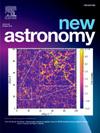How inclusion of binaries affects the fitting of giant branches and determination of fundamental parameters of star clusters
IF 2.1
4区 物理与天体物理
Q2 ASTRONOMY & ASTROPHYSICS
引用次数: 0
Abstract
Open clusters (OCs) play an important role in the study of star formation and the structural evolution of the Milky Way. This paper fits the color-magnitude diagrams (CMDs) of 17 OCs using a tool called Powerful CMD, with the aim of studying the effect of inclusion of binary stars on the fitting of cluster CMDs with clear giant branches. The fitting results of these star clusters were analyzed and compared under two scenarios, i.e., single-star isochrone fitting and binary-star isochrone fitting. In the binary-star isochrone fitting, the binary fraction is greater than 0 and no larger than 1, which is determined by Powerful CMD based on the goodness of fit to the CMD. The research findings indicate that binaries enhance the goodness of fit for all sample star clusters. In particular, the fit to giant branches becomes better when binary stars are considered. Furthermore, binaries contribute to improving accuracy in determining the fundamental parameters such as age, color excess, and distance modulus for star clusters, because the parameter uncertainties become smaller when binary stars are included in theoretical models. Moreover, the distance modulus and age of clusters become larger when binary-star isochrones are used instead single-star isochrones. The results suggest that one should not neglect the influence of binaries on the shape of giant branches and their role in determining fundamental parameters, in the CMD studies of star clusters.
双星的包含如何影响巨大分支的拟合和星团基本参数的确定
疏散星团(OCs)在恒星形成和银河系结构演化的研究中起着重要作用。本文利用一种名为Powerful CMD的工具对17个星团的彩色星等图进行拟合,目的是研究双星的包含对具有清晰巨支星团的彩色星等图拟合的影响。对这些星团在单星等时拟合和双星等时拟合两种情况下的拟合结果进行了分析和比较。在双星等时拟合中,二进制分数大于0且不大于1,这是由power CMD根据对CMD的拟合优度确定的。研究结果表明,双星提高了所有样本星团的拟合优度。特别是,当考虑双星时,对巨大分支的拟合变得更好。此外,双星有助于提高确定星团基本参数的准确性,如年龄、颜色过剩和距离模量,因为当双星被包括在理论模型中时,参数的不确定性会变小。此外,当使用双星等时线代替单星等时线时,星团的距离模量和年龄会变大。结果表明,在星团的CMD研究中,不应忽视双星对巨支形状的影响及其在确定基本参数方面的作用。
本文章由计算机程序翻译,如有差异,请以英文原文为准。
求助全文
约1分钟内获得全文
求助全文
来源期刊

New Astronomy
地学天文-天文与天体物理
CiteScore
4.00
自引率
10.00%
发文量
109
审稿时长
13.6 weeks
期刊介绍:
New Astronomy publishes articles in all fields of astronomy and astrophysics, with a particular focus on computational astronomy: mathematical and astronomy techniques and methodology, simulations, modelling and numerical results and computational techniques in instrumentation.
New Astronomy includes full length research articles and review articles. The journal covers solar, stellar, galactic and extragalactic astronomy and astrophysics. It reports on original research in all wavelength bands, ranging from radio to gamma-ray.
 求助内容:
求助内容: 应助结果提醒方式:
应助结果提醒方式:


